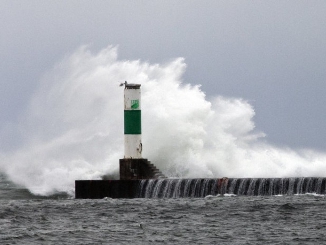 First reported by mlive.com. As the Great Lakes swimming season starts, the data is in. Each Great Lake has unique shorelines and dangers, but Lake Michigan stands alone as the deadliest Great Lake. The biggest reason: Swift currents.
First reported by mlive.com. As the Great Lakes swimming season starts, the data is in. Each Great Lake has unique shorelines and dangers, but Lake Michigan stands alone as the deadliest Great Lake. The biggest reason: Swift currents.
Lake Michigan’s distinctive configuration — as a 307-mile long lake with twin, uninterrupted shorelines running north to south — make it especially vulnerable to two dangerous types of currents, called rip and longshore.
The numbers tell the story, thanks to comprehensive data accumulated by federal weather safety experts during the past 13 years.
Lake Michigan has had 82 drownings and 243 rescues of swimmers caught in currents since 2002. Those 325 current-related incidents are more than double the 126 reports – 62 drownings and 64 rescues – in the four other Great Lakes combined.
These statistics, compiled by the National Weather Service and Michigan Sea Grant, show Lake Michigan averaging about six current-related deaths each year. Lake Erie is next with about two deaths per year. Lake Huron has about 1 death, and lakes Superior and Ontario are less than 1.
Most of the water rescues and drownings fall under a category called “classic rip.” As an increasing amount of water is forced ashore by high winds, it has to eventually escape. A rip current forms when water begins surging away from the beach and out to mid-lake.
Other currents include those spawned by winds parallel to the shore — longshore currents — and those alongside piers and other structures.
Each of the Great Lakes possess danger, but Lake Michigan is unmatched, said Bob Dukesherer, a senior forecaster and marine program leader for the weather service office in Grand Rapids.
The lake’s shoreline configuration amplifies the risk.
“There are layers upon layers of threats that could pose problems for swimmers,” Dukesherer said. “Its physical makeup helps create large waves, especially when winds blow from the north and west.”
Wind over the open water of Lake Michigan, or fetch, is greatest along a 307-mile journey from its northern extent to its southern shore and 118 miles wide from Wisconsin to West Michigan. That allows waves to build for hundreds of miles before crashing onto beaches.
Another simple factor is the population centers, including the Chicago metro area and West Michigan, that feature popular recreational beaches and vacation hotspots putting more people in the water than in the other lakes.
Other lakes share similar risks but seldom teem with people on the dangerous days. Lake Superior, for instance, can be a treacherous body, but is without Lake Michigan’s stretches of sandy beaches and visitors.
The Great Lakes Surf Rescue Project has a broader measure of drownings, going beyond current-related deaths and also adding in cold water, large waves and other recreational activities.
Here, Lake Michigan again leads the rest, with 24 drownings in 2014. Lake Erie had 17 such accidents.
Lakeshore communities frequently play host to the organization for its public seminars and lifeguard classes.
Education is key when people plan to head to shore, says Dave Benjamin, executive director of the organization.
“More and more is spent to lead people to the water, and when people drown, there’s a certain stigma. You blame the victim and people think it can’t happen to them,” Benjamin said. “But many people don’t have the basic swimming abilities to save their lives, and people don’t know drowning is one of the leading causes of accidental deaths.
“I’m not opposed to money being spent in advertising and tourism to bring people to the water, but then you have to question, how much is being spent to educate the public?”
A person won’t yell, splash and wave their hands when drowning, Benjamin said. Instead, it is a quiet phenomenon.
Beachgoers are encouraged to check the National Weather Service’s newest, interactive beach forecast website to view current lake conditions. When the weather is expected to be at its worst, beach hazard statements will be issued to detail the threat.
By Andrew Krietz who covers breaking, politics and transportation news for MLive and The Grand Rapids Press.
